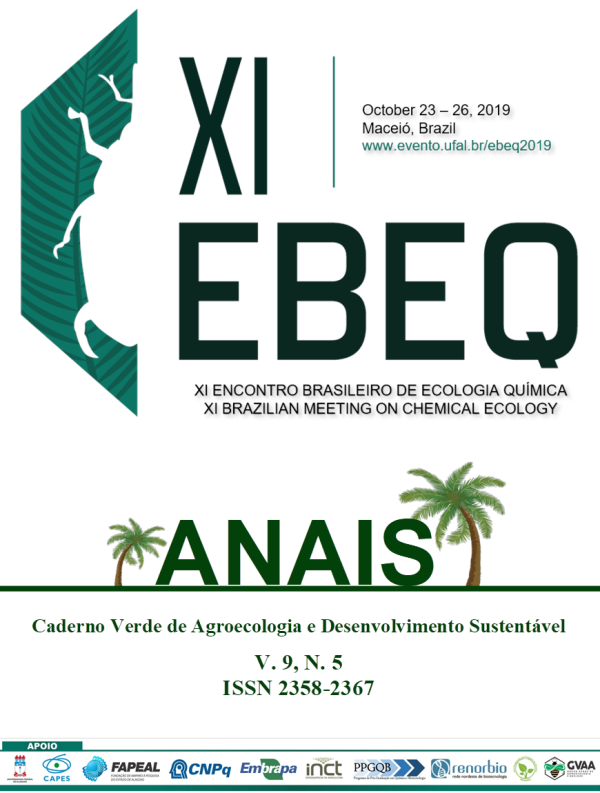THE MOLECULAR AND CELLULAR BASIS OF HUMIDITY SENSING IN Drosophila melanogaster
Resumo
Humidity is an omnipresent climatic factor that influences the fitness, reproductive behaviour and geographic distribution of land-living animals, including humans. Insects in particular use humidity cues to navigate the environment, for example disease-vectors such as mosquitoes and tsetse flies use this sense to find hosts to bite. Even though hygrosensation is vital for the behaviour of many animals, the mechanism of how insects sense humidity remains poorly understood. Using a simple behavioral assay, it was found that four receptor genes expressed in humidity receptor neurons (HRNs) IR40a, IR93a, IR68a and IR25a (collectively referred to as hygroIRs) are required for humidity preference in D. melanogaster. IRs are distant relatives of ionotropic glutamate receptors, that functions primarily as chemoreceptors. The HRNs are located in an invagination of the posterior side of the antenna: the sacculus. There, one moist neuron (responding to increases in humidity), one dry neuron (responding to decreases in humidity) and one hygrocool neuron (responding to cooling but not required for temperature preference behavior) are housed together in a sensillum forming a hygrosensory ‘triad’. Applying two-photon calcium imaging and confocal microscopy, it was observed that dry neurons express and depend on IR40a and moist neurons depend on IR68a. Genetic inactivation of IR40a or IR68a results in both an aberrant physiological response to humidity stimulus and to a deficiency in humidity-guided behavior. IR25a and IR93a mediate both humidity (putatively as co-receptors) and temperature preference (the expression of IR93a and IR25a includes thermosensory neurons of the arista). Although the hygroIRs are necessary for hygrosensation, it remains an open question what activates these receptors. Taken together, these results suggest that the preference for a specific humidity range depends on specialized sacculus neurons and illustrate the logic of how ethologically relevant combinations of sensory cues can be processed together to produce adaptive behavioral responses.
Downloads
Publicado
Como Citar
Edição
Seção
Licença
Termo de cessão de direitos autorias
Esta é uma revista de acesso livre, em que, utiliza o termo de cessão seguindo a lei nº 9.610/1998, que altera, atualiza e consolida a legislação sobre direitos autorais no Brasil.
O(s) autor(es) doravante designado(s) CEDENTE, por meio desta, publica a OBRA no Caderno Verde de Agroecologia e Desenvolvimento Sustentável, representada pelo Grupo Verde de Agroecologia e Abelhas (GVAA), estabelecida na Rua Vicente Alves da Silva, 101, Bairro Petrópolis, Cidade de Pombal, Paraíba, Brasil. Caixa Postal 54 CEP 58840-000 doravante designada CESSIONÁRIA, nas condições descritas a seguir:
O CEDENTE declara que é (são) autor(es) e titular(es) da propriedade dos direitos autorais da OBRA submetida.
O CEDENTE declara que a OBRA não infringe direitos autorais e/ou outros direitos de propriedade de terceiros, que a divulgação de imagens (caso as mesmas existam) foi autorizada e que assume integral responsabilidade moral e/ou patrimonial, pelo seu conteúdo, perante terceiros.
O CEDENTE mantêm os direitos autorais e concedem à revista o direito de divulgação da OBRA, com o trabalho simultaneamente licenciado sob a Licença Creative Commons do tipo atribuição CC-BY.
O CEDENTE têm autorização para distribuição não-exclusiva da versão do trabalho publicada nesta revista.
O CEDENTE têm permissão e são estimulados a publicar e distribuir seu trabalho online (ex.: em repositórios institucionais ou na sua página pessoal) a qualquer ponto antes ou durante o processo editorial, já que isso pode gerar alterações produtivas, bem como aumentar o impacto e a citação do trabalho publicado.










